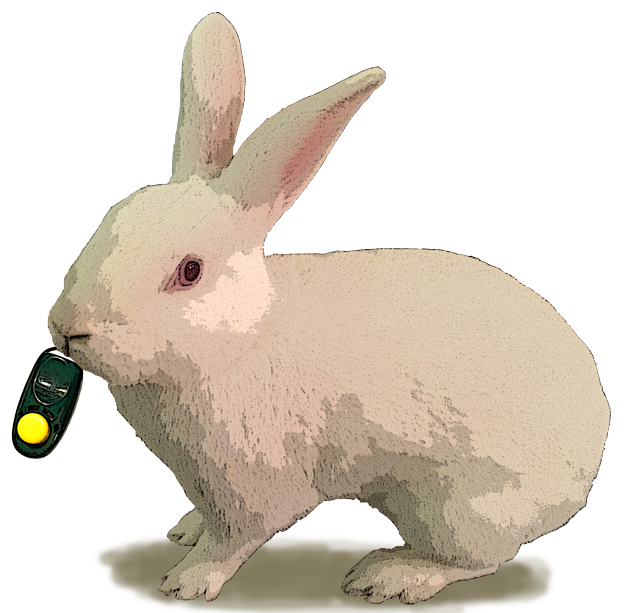
In the world of professional animal trainers, there seem to be only two kinds. Most everyone is familiar with dog trainers. From there, it veers immediately into zoos and the circus. I was willing to accept this as reasonable for most of my life. Not any more. I now believe that for any species of pet, both human and animal will benefit if training is part of the picture. And not just any kind of training, either. It should be force-free and based on positive reinforcement.
What made me so adamant about training, even for rabbits? After I watched this video by Small Pet Select of Dr. Guen Bradbury I realized that training is the best form of communication that we have with another species. If you are going to live with someone, things are going to work out a lot better if you can talk to each other!
Are we talking, like, Dr. Doolittle here? I still vividly recall seeing the original (1967) movie as a small child. I wished with all my heart that I could talk to animals, too! But even then, I knew that was just a fairy tale. Or was it?
An expert trainer essentially is Dr. Doolittle! Good trainers learn to “hear” what animals are saying by how they behave, their body language, and their responses to stimuli. They become skilled at conveying messages to animals through their own body language, along with very precise timing of cues and treats.
Why Are There Professional Dog Trainers But Not Rabbit Trainers?
Many answers to this question, IMHO. To start with, there’s a lot less attention paid to rabbits as house pets than dogs. But I think the main reason is because forcing dogs to do things can be downright dangerous. Though rabbits can injure, severe harm from a bunny is a rarity. I can’t find a single instance where a lagomorph has ever killed anyone, at least outside of a Monty Python Film.
Training dogs, especially large ones (and zoo animals for that matter) became a necessity in order to coexist with them safely, Over time, taking a puppy to puppy classes and older dogs to “obedience school” has become an accepted best practice for dog owners. Two positive things result:
- We can get a trained dog to voluntarily do things we want or need him to do in response to cues.
- Trained dogs have enhanced abilities to cope with the situations they encounter in a human-centric world.
In contrast, to get a pet rabbit to do what’s needed, people still routinely catch and pick up the bunny, forcing her to comply. Of course, most people are careful to do this in a way that avoids injuring or terrorizing the creature. Still, I would argue that just because force works for controlling bunnies, that doesn’t make it the best approach. Being restrained is at least a little bit stressful for any animal. Don’t you find it so? This is especially true for bunnies because of their place as prey animals in the food chain, as I explained a previous post.
Why not push the envelope a little and give rabbits the same advantages we give dogs?
The Benefits of Training a Rabbit
I think you can get the same two positive results from training a rabbit that I mentioned above for dogs.
- You can get a rabbit to do something you want or need her to do just by giving a cue.
- Training can give a bunny ways of coping with the things that go on in your home that would otherwise terrify him.
The whole situation becomes much less stressful for everyone. I don’t know about you, but here’s how things used to go in my house. I could approach and touch my bunnies any time and they wouldn’t bat an eyelid. Unless it was 2:30 and we had a 3 pm vet appointment. Somehow they would know, without us even reaching in their direction, that we were coming to pick them up, and they’d instantly fly into motion. The next 5-10 minutes would be a flurry of strategic herding, including commando crawling repeatedly between the legs of the dining table. It would climax in snatching a poor, protesting rabbit off the carpet and haphazardly trying to guide flailing legs through the opening of the pet crate followed by a gush of desperate apology on my part.
These days all my rabbits get crate trained. Now when it’s time to go somewhere I get out the crate, sprinkle in some pellets, set it on the floor with the door open, and they happily load themselves in. Done.
I also believe that daily training sessions can reduce unwanted so-called “destructive” behavior in pet rabbits. With dogs, some of these kinds of problems are caused by boredom. The mental workout that a dog gets from being trained can keep him stimulated enough that he doesn’t need to devise so many extra-curricular activities for himself. The same could very well be true of bunnies.
Don’t Freak Out. Anyone can do this.
Professional trainers really are wizards in my view. I watch videos of Ken Ramirez or Barbara Heidenreich, who are top of their field, and I know I will never be that good. I’ll never be able to seemingly wave my magic treat bag and transform an animal the way they do. Might as well be a fairy tale! But you don’t need to be that good to have an impact.
Think of it this way – if you decide to go on a vacation in Italy, you aren’t going to be able to become a fluent speaker of Italian overnight. However, it sure could come in handy if you pick up a few words or phrases in Italian, and just about anybody can handle that. When David and I went on our honeymoon in Tuscany, we memorized “Non mangiamo coniglio!” which means “we don’t eat rabbit!”. This was to ensure that there would not be any culinary catastrophes due to misinterpreted menus. Years later, I still remember that phrase!
But What Would We Talk About?
Perhaps you can’t think of a conversation starter to engage your rabbit. You already spend time together, wordlessly, and that is lovely. You gently stroke your bunny where he likes it best. You give him hay and treats. You feel this says “I love you” and I agree! Is there more we need to discuss?
I think so. Here’s some topics I would put at the top of the list:
- Someone’s here to see you. Come on out and say “Hi!”.
- How about you move over there?
- It’s late. You should go to bed now.
- It’s time to vacuum. How about you go somewhere that you’ll feel safe, and don’t panic.
- Your toenails look a little long. Just hold still a minute while I trim one.
I have worked on all of these things with my own rabbits. (I haven’t quite achieved #5, but I am making progress!) They all have one big thing in common: if we can have these conversations calmly, both my rabbit and I will find life a lot less stressful! Wouldn’t that be nice?
Can Rabbits Learn Tricks Too?
Oh yes, those long eared lads and lasses can definitely learn tricks. I believe practical management behaviors like the ones above are far more important, but if you’re going to train and you want to teach tricks, go for it! So long as it’s all positive reinforcement, your rabbit will have a lovely time working with you. Here is a video of the late, great Pixel when I trained her to “play soccer.”
Where to Begin?
There are several good references on rabbit training that can help you get started. Here are some I recommend.
- Getting Started: Clicking with Your Rabbit by Joan Orr and Teresa Lewin
This was my first rabbit training manual. I was able to teach several simple behaviors and get started on my rabbit training journey with it. It’s a quick read! - Bunny Training 101 DVD by Barbara Heidenreich
This is a very good video tutorial by a very talented trainer. Barbara frequently works with smaller pets like rabbits and birds. - Behavioural Problems in Rabbits by Dr. Guen Bradbury
Dr. Bradbury uses training mainly to solve behavior problems but basic information about training is included at the end of Chapter 4. If you are also having behavioral problems with your sweetie-pie, this book does double duty!
You may be able to find some free references online as well. For instance, Dr. Bradbury has a fine set of videos on her YouTube channel.
While I’m not as skilled as those authors, I have been practicing training rabbits for over a decade as an amateur. I also completed a certification in positive-reinforcement dog training for the explicit purpose of refining and improving my skills. (The same concepts used with dogs are applicable to rabbits, though some of the mechanics differ.) I plan to share some ideas and videos on my blog that I hope will help. You can subscribe by entering your email address on the subscription form .
One thing any trainer who has worked with these puff-tails will tell you: take it slow and keep training sessions short. Celebrate any progress, small as it may seem. When Pixel and I first started working on soccer, even turning her head toward the ball or touching it slightly with her nose was enough to warrant a click and a treat. It’s surprising what a couple minutes at a time can achieve with regularity. So, DoLittle but also DoOften.
If this seems like a lot of work, take a step back. You want to spend time with your pet, doing something interesting together, right? Training is the perfect shared hobby for you and your bun. He will enjoy the game and the treats; you will enjoy seeing him have fun. And when you succeed in training a behavior, it’s such a thrill! You have really learned to talk to each other!
The Fl uffy Tail of This Blog Post
uffy Tail of This Blog Post
Training is as valuable for pet rabbits as it is for dogs or any other pet. It can give you a way to move your bun where you need him to go without having to capture and restrain him, and provide many hours of shared entertainment for both of you. Plus the mental stimulation that training provides may take the place of less favored rabbit habits. I hope more bun owners start to try it!
Marcy says:
Great post. Thanks! Marcy from SaveABunny
Melinda says:
Thanks Marcy! That means a lot coming from someone who does so many great things with and for rabbits! Cheers, and best wishes to everyone at SaveABunny!